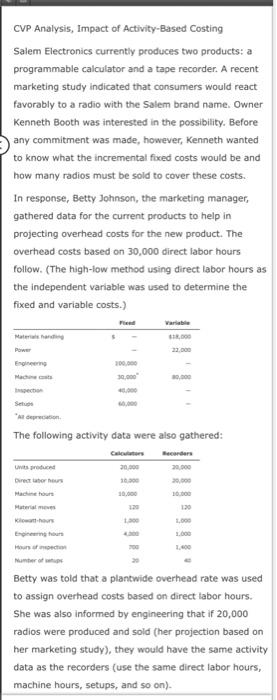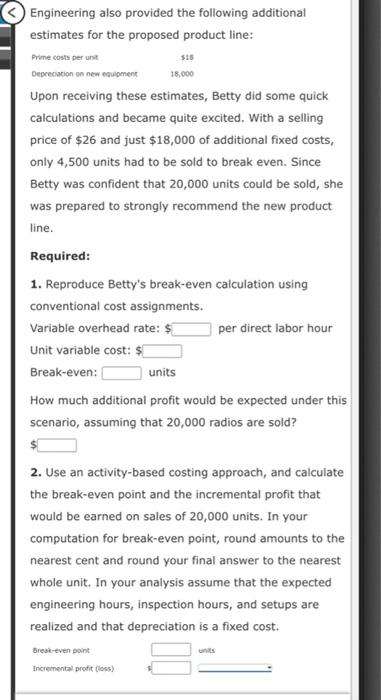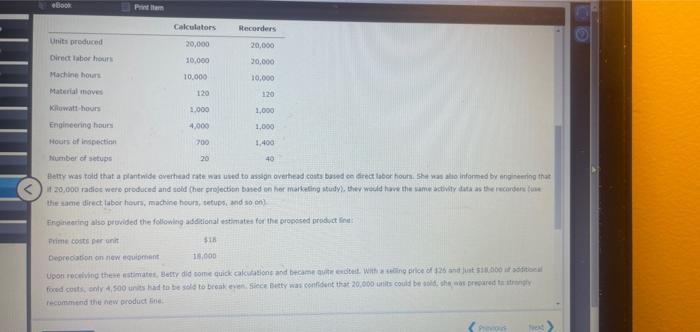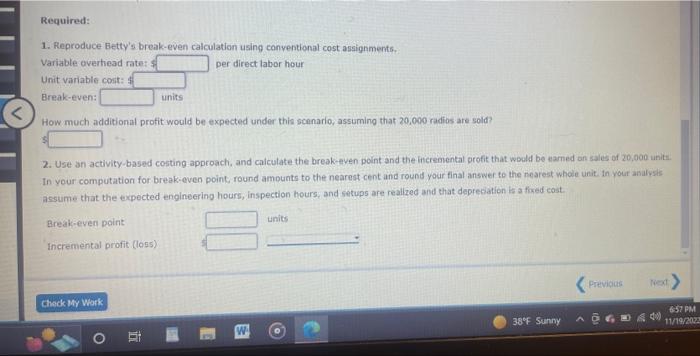CVP Analysis, Impact of Activity-Based Costing Salem Electronics currently produces two products: a programmable calculator and a tape recorder. A recent marketing study indicated that consumers would react favorably to a radio with the Salem brand name. Owner Kenneth Booth was interested in the possibility. Before any commitment was made, however, Kenneth wanted to know what the incremental fixed costs would be and how many radios must be sold to cover these costs. In response, Betty Johnson, the marketing manager, gathered data for the current products to help in projecting overhead costs for the new product. The overhead costs based on 30,000 direct labor hours follow. (The high-low method using direct labor hours as the independent variable was used to determine the fixed and variable costs.) The following activity data were also gathered: Betty was told that a plantwide overhead rate was used to assign overhead costs based on direct labor hours. She was also informed by engineering that if 20,000 radios were produced and sold (her projection based on her marketing study), they would have the same activity data as the recorders (use the same direct labor hours, machine hours, setups, and so on). Engineering also provided the following additional estimates for the proposed product line: Upon receiving these estimates, Betty did some quick calculations and became quite excited. With a selling price of $26 and just $18,000 of additional fixed costs, only 4,500 units had to be sold to break even. Since Betty was confident that 20,000 units could be sold, she was prepared to strongly recommend the new product line. Required: 1. Reproduce Betty's break-even calculation using conventional cost assignments. Variable overhead rate: \$\$ per direct labor hour Unit variable cost: \$ Break-even: units How much additional profit would be expected under this scenario, assuming that 20,000 radios are sold? $ 2. Use an activity-based costing approach, and calculate the break-even point and the incremental profit that would be earned on sales of 20,000 units. In your computation for break-even point, round amounts to the nearest cent and round your final answer to the nearest whole unit. In your analysis assume that the expected engineering hours, inspection hours, and setups are CVP Anahysis, Impact of Activity. Hassed Costing would react fayorably to a radio with the 5 alem brand name. Owner kenneth looth was interested in the possitility. Bafore atiy commitrivent was made. however. kenneth wanted to know what the incremental fixed sosta would be and how many fidios must be sold to cover these cests. In resontil, Betty Johnson, the marketing manager, gathered data for the current products to help in prolecting overhead coste for the new product. The overthead costs based on 30,000 direct laboe hours follow. The high low method veing direct labor hours as the indeperindert vadable was used to determine the floced and variable costs. The following activity data were also gatheredt? Fecummtend the hew product Fitie. 1. Reproduce Betty's break-even calculation using conyentional cost assignments. Variable dverhead ratet 5 per direct labor hour Unit variable corit: 4 Break-even: units How much additional profit would be expected under this scenario, assuming that 20,000 radios are sold? 2. Uset an activity-based costing approach, and calculate the break-even point and the lincremental profit that would be aarmed an sales of 20 , 000 unit In your computation for break-even point, round amounts to the nearest cent and round your final answer to the rearest whole unit. in yout analysis assume that the expected engineering hours, inspection hours, and setups are realized and that deprecition is a fined cost











